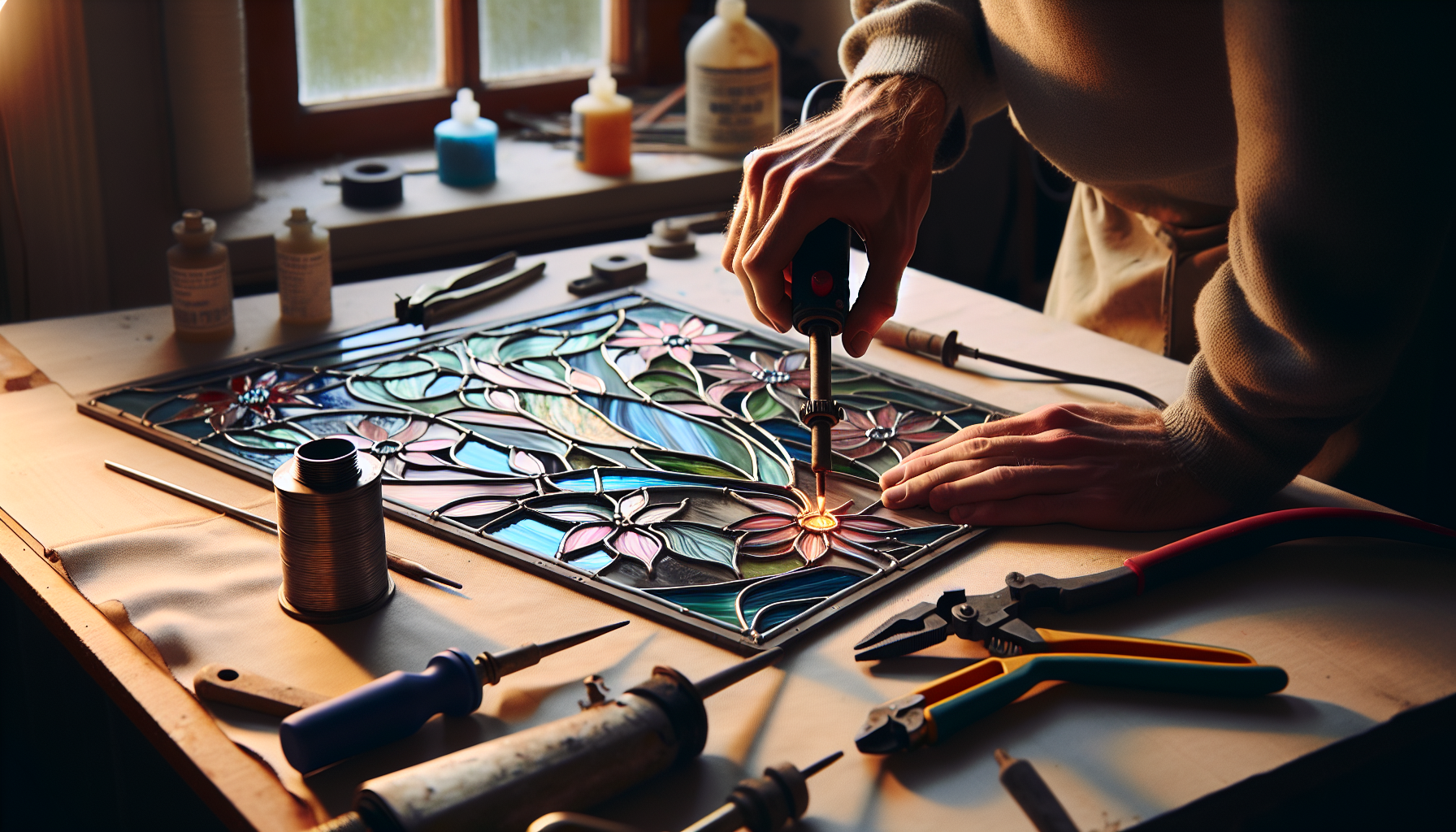Why Is My Solder Not Flowing Stained Glass?
Have you ever found yourself frustrated with your solder not flowing properly while working on your stained glass projects? It can be incredibly discouraging when you’re excited to finish a piece, but your solder just won’t cooperate. But fear not, because in this article, we’ll explore some common reasons why your solder may not be flowing as smoothly as you’d like in stained glass work. With a few adjustments and some troubleshooting, you’ll be back on track to creating beautifully flowing solder lines in no time. So let’s jump right in and uncover the secrets to ensuring your solder flows effortlessly in stained glass projects.
Common Reasons for Solder Not Flowing in Stained Glass
Solder not flowing smoothly in stained glass projects can be frustrating for any artist. It can result in weak joints, unattractive finished pieces, and wasted time and effort. However, there are several common reasons why solder may not be flowing as desired. By understanding and addressing these issues, you can ensure that your soldering process is successful and your stained glass projects turn out beautifully.
Insufficient Flux
One of the most common reasons for solder not flowing properly is insufficient flux. Flux plays a crucial role in the soldering process as it cleans the metal surfaces and helps the solder bond with them. Without enough flux, the solder may struggle to adhere to the glass or metal and create a smooth, even flow.
To address this issue, it is important to understand the role of flux in soldering. Flux acts as a cleaning agent, removing any dirt, oil, or oxidation that may prevent the solder from adhering properly. Choosing the right flux for stained glass is essential. There are different types of flux available, including liquid and paste forms. It is important to select a flux that is specifically designed for stained glass to ensure optimal results.
When applying flux, make sure to use an adequate amount. Applying too little flux can result in poor adhesion, while applying too much can create excessive residue. Additionally, be aware that flux may need to be reapplied during the soldering process if it becomes diluted or contaminated.
Dirty Glass Surface
Another common reason for solder not flowing smoothly is a dirty glass surface. Any dirt, oil, or grease on the glass can hinder the adhesion of solder and lead to uneven flow. Therefore, it is crucial to clean the glass surface thoroughly before soldering.
Start by removing any loose dirt or debris from the glass using a soft brush or cloth. Next, focus on removing any oil or grease. These substances are often left behind by fingerprints or handling the glass with bare hands. To remove oil and grease, use an appropriate cleaning agent such as isopropyl alcohol or mild dish soap diluted in water. Avoid using harsh chemicals that may damage the glass or strip off any protective coatings.
After cleaning the glass, make sure to dry it properly. Excess moisture can also interfere with solder flow. Use a lint-free cloth or air-dry the glass to ensure it is completely dry before proceeding with soldering.

Inadequate Temperature
Temperature plays a crucial role in soldering stained glass. If the temperature is too low, the solder may not melt properly and flow smoothly. On the other hand, if the temperature is too high, it can lead to overheating, damage to the glass, or poor solder adhesion.
To achieve the correct soldering temperature, it is recommended to use an adjustable soldering iron. This way, you can set the temperature according to the specific requirements of your project. The optimal temperature for soldering stained glass is usually around 600 to 650 degrees Fahrenheit (315 to 343 degrees Celsius). However, it is important to note that the exact temperature may vary depending on the materials and techniques used.
Ensuring proper heat transfer is essential for achieving a smooth solder flow. Make sure the soldering iron tip is clean and properly tinned. Tinning the tip involves coating it with a thin layer of solder to enhance heat transfer and prevent oxidation. If the tip is dirty or heavily oxidized, it may not heat up properly or transfer heat effectively to the solder.
Avoiding overheating or underheating is also crucial. Overheating can damage the glass, while underheating can result in the solder not melting completely. Practice proper soldering techniques and pay attention to the temperature throughout the process to achieve the desired solder flow.
Poor Soldering Technique
Even with sufficient flux, a clean glass surface, and the correct temperature, poor soldering technique can still result in solder not flowing smoothly. It is important to develop good soldering skills and follow proper techniques to achieve consistent and professional results.
One key aspect of soldering technique is proper flux distribution. Ensure that the flux is evenly applied to the areas being soldered. Uneven distribution can lead to areas with insufficient flux, hindering solder flow.
Applying the right amount of solder is also important. Too little solder may result in weak joints, while too much can create unsightly blobs or “overfill” the joint. Practice using the correct amount of solder for different joints and be attentive to achieve a clean, even flow.
Adequate contact with the copper foil or lead came is crucial for proper solder flow. Make sure the foiled or came edges are firmly pressed against the glass to ensure a strong bond and allow the solder to flow smoothly along the joint.
Avoid excessive heat or quick movements when soldering. Excessive heat can lead to scorched or damaged glass, while quick movements can result in an uneven, bumpy solder line. Take your time, apply steady heat, and move the soldering iron in a smooth, controlled manner to achieve the desired solder flow.

Using the Correct Type of Solder
Using the correct type of solder is essential for achieving optimal solder flow in stained glass projects. Different solder alloys have different melting temperatures, flow characteristics, and compatibility with glass and metal. Choosing the suitable solder alloy for your project is crucial for achieving the desired results.
Common solder alloys for stained glass include 50/50, 60/40, and lead-free solders. Each alloy has its own advantages and considerations. It is recommended to consult with experienced stained glass artists or refer to manufacturer guidelines to select the appropriate solder alloy for your specific project.
Understanding the role of flux in Different solder alloys is also important. While some solder alloys may already contain flux, others may require the use of additional flux. Make sure to follow the manufacturer’s recommendations regarding flux usage to ensure optimal solder flow.
Preventing solder incompatibility issues is also important. Some solder alloys may not adhere well to certain types of glass or metal. Perform compatibility tests before starting a project to ensure that the solder and materials will work well together and produce the desired solder flow.
Preheating the Stained Glass
Preheating the stained glass can help promote smoother solder flow and reduce the chances of glass breakage. Preheating is particularly useful when working with large or thick pieces of glass.
The importance of preheating lies in expanding the glass and allowing the solder to flow more easily. By heating the glass before soldering, it becomes more pliable, reducing the chances of cracks or breakage during the soldering process.
Determining the optimal preheating temperature depends on the specific glass and project requirements. Generally, a preheating temperature of around 300 to 400 degrees Fahrenheit (149 to 204 degrees Celsius) is recommended, but it is important to adjust the temperature according to the size and thickness of the glass.
Precautions should be taken when preheating the glass. Avoid direct contact between the glass and the heat source. Place the glass on a suitable heat-resistant surface or use a preheating oven specifically designed for stained glass. It is important to follow proper safety procedures to prevent accidents or damage to the glass.
Troubleshooting Solder Flow Issues
If solder is still not flowing smoothly despite addressing the common reasons mentioned above, it is important to troubleshoot the specific issues.
Inspecting the flux reservoir is the first step. Make sure the flux is not contaminated, diluted, or expired. Contaminated flux can hinder solder flow, while expired flux may not be as effective. Clean or replace the flux as necessary to ensure optimal results.
Examining the solder tip is also crucial. A damaged or worn-out tip may not transfer heat effectively, resulting in poor solder flow. Replace the tip if necessary and make sure to regularly clean and maintain the soldering iron to optimize its performance.
Checking for cold solder joints is another troubleshooting step. Cold solder joints occur when the solder does not fully melt or bond with the metal surfaces. They can result in weak or unsightly joints. Inspect the joints and reheat them if necessary to achieve consistent flow and strong bonds.
Utilizing soldering aids or accessories can also help troubleshoot solder flow issues. Some projects may require the use of specialized tools or techniques to achieve optimal results. Consult with experienced stained glass artists or refer to instructional resources for guidance on using soldering aids or accessories.
Preventing Excessive Oxidation
Oxidation can hinder solder flow by creating a barrier between the solder and the metal surfaces. Minimizing exposure to oxygen is crucial in preventing excessive oxidation and ensuring smooth solder flow.
Understand the oxidation process and take appropriate measures to minimize its occurrence. Avoid leaving the glass or metal surfaces exposed to oxygen for extended periods. Cover or seal the materials when not in use to prevent oxidation.
Using anti-oxidation agents or penetrating oils can also help prevent excessive oxidation. These substances create a barrier between the metal surfaces and the oxygen, reducing the chances of oxidation occurring. Apply the anti-oxidation agents or penetrating oils according to the manufacturer’s recommendations and ensure they are compatible with the stained glass materials.
Storing and handling solder properly can also prevent excessive oxidation. Keep solder in a dry, airtight container to minimize its exposure to oxygen. Use clean tools and equipment and avoid touching the solder or glass surfaces with bare hands to prevent oils or contaminants from interfering with solder flow.
Troubleshooting Solder Not Flowing After Multiple Attempts
If solder is still not flowing smoothly after multiple attempts, it may indicate an underlying issue that needs to be addressed.
Start by identifying the specific problem you are facing. Evaluate the soldering process, the materials used, and the techniques employed to identify any potential areas for improvement or modification.
Seeking guidance from experienced stained glass artists can also be beneficial. They can provide valuable insights, techniques, or troubleshooting strategies based on their expertise and experience. Joining stained glass communities, participating in workshops, or seeking mentorship can help you overcome solder flow issues and enhance your skills.
Consideration of advanced techniques or alternatives may also be necessary. Some projects may require specialized techniques or alternative methods to achieve optimal solder flow. Experiment with different techniques or seek guidance from experts to find the approach that works best for your specific project.
Reevaluating the glass and soldering materials is another step to take. Sometimes, the specific glass or soldering materials used may not be compatible or suitable for the desired solder flow. Consider reviewing the choices of glass, solder alloys, flux, or other materials and make adjustments as necessary to achieve the desired results.
In conclusion, solder not flowing smoothly in stained glass projects can be addressed by understanding and addressing common reasons such as insufficient flux, dirty glass surface, inadequate temperature, and poor soldering technique. Using the correct type of solder, preheating the stained glass, troubleshooting solder flow issues, preventing excessive oxidation, and reevaluating the glass and soldering materials are also important considerations. By implementing these suggestions, you can ensure that your solder flows smoothly, resulting in beautifully crafted stained glass pieces.


